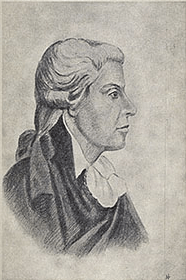Felice Fontana

Felice Fontana (15 April 1730 – 10 March 1805) was an Italian physicist who discovered the water gas shift reaction in 1780. He is also credited with launching modern toxicology and investigating the human eye.
Early life
He was born at Pomarolo, and studied Anatomy and Physiology in the University of Padua.
Teaching
In 1755 moved to Bologna. In 1765 he moved again, this time for Pisa, where he taught Logic. In 1766 he also taught Physics, became court physicist, with the task of creating a museum of natural history and physics. The museum, then in Palazzo Pitti in Florence, opened in 1775. It is in this period that he takes an interest in poisons and iris motions, among other things.
1775-80: Travels
From 1775 to 1780 he travelled through Europe. Already in 1775 he published a treatise, 'Ricerche fisiche sopra l'aria fissa', on Carbon dioxide (opposing to, among others, the theory of Torbern Bergman that it was acid in itself) and 1779-1780 sees his seminal research on curare. In 1779 he offers the London Royal Society two memories on chemistry: 'Experiments and observations on the inflammable air breathed by various animals', where he denied that flammable air was fit for breathing, in accordance with Joseph Priestley, and 'Account of the airs extracted from different kinds of water; with thoughts on the salubrity of air at different places'.
General Principles of Solidity and Fluidity of Bodies
In 1783 he published Principi generali della solidità e della fluidità dé corpi, expounding a theory on material states of his own: he thought that matter was subject to two newtonian forces, an attractive and an expansive one. The latter, though, wasn't repulsive as Newton thought, but the result of a combination of simple matter (solid in its natural state) with "heat matter" that drove apart molecules turning bodies into fluids and vapours. In the case of gases, that never became liquid in absence of heat, he considered the interference of another principle: the "flogisto", principle of fluidity and flammability.
Major works

- Dei moti dell'iride (Lucca, 1765);
- Nuove osservazioni sopra i globetti rossi del sangue (1766);
- De irritabilitatis legibus... (1767);
- Ricerche fisiche sopra il veleno della vipera (Lucca, 1767);
- Descrizione ed uso di alcuni stromenti per misurare la salubrità dell'aria (Firenze, 1775);
- Ricerche fisiche sopra l'aria fissa (Firenze, 1775);
- Recherches physiques sur la nature de l'air nitreux et de l'air déphlogistiqué (Paris, 1776);
- Traité sur le vénin de la vipere, sur les poisons americains... (Firenze, 1781, 2 voll.);
- Opuscoli scientifici (Firenze, 1783).
In 1792, he was elected a foreign member of the Royal Swedish Academy of Sciences.
He died in Florence.
Family
His brother was mathematician Gregorio Fontana.
See also
External links
- Felice Fontana
 "Felice Fontana". Catholic Encyclopedia. New York: Robert Appleton Company. 1913.
"Felice Fontana". Catholic Encyclopedia. New York: Robert Appleton Company. 1913.- Zoologica Göttingen State and University Library Traité Sur Le Vénin De La Vipere Sur Les Poisons Americains Sur Le Laurier-Cerise Et Sur Quelques Autres Poisons Végetaux 1781
References
|